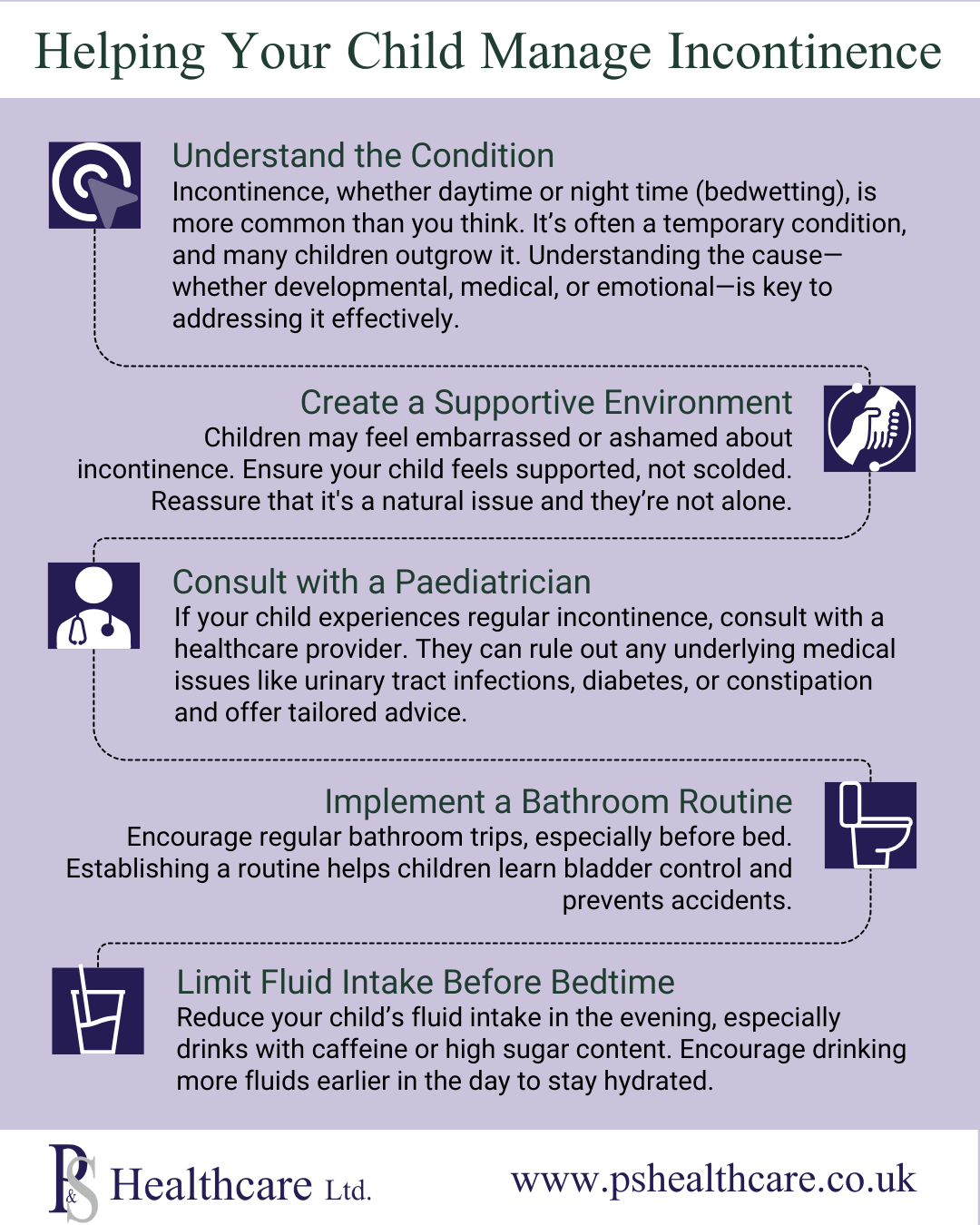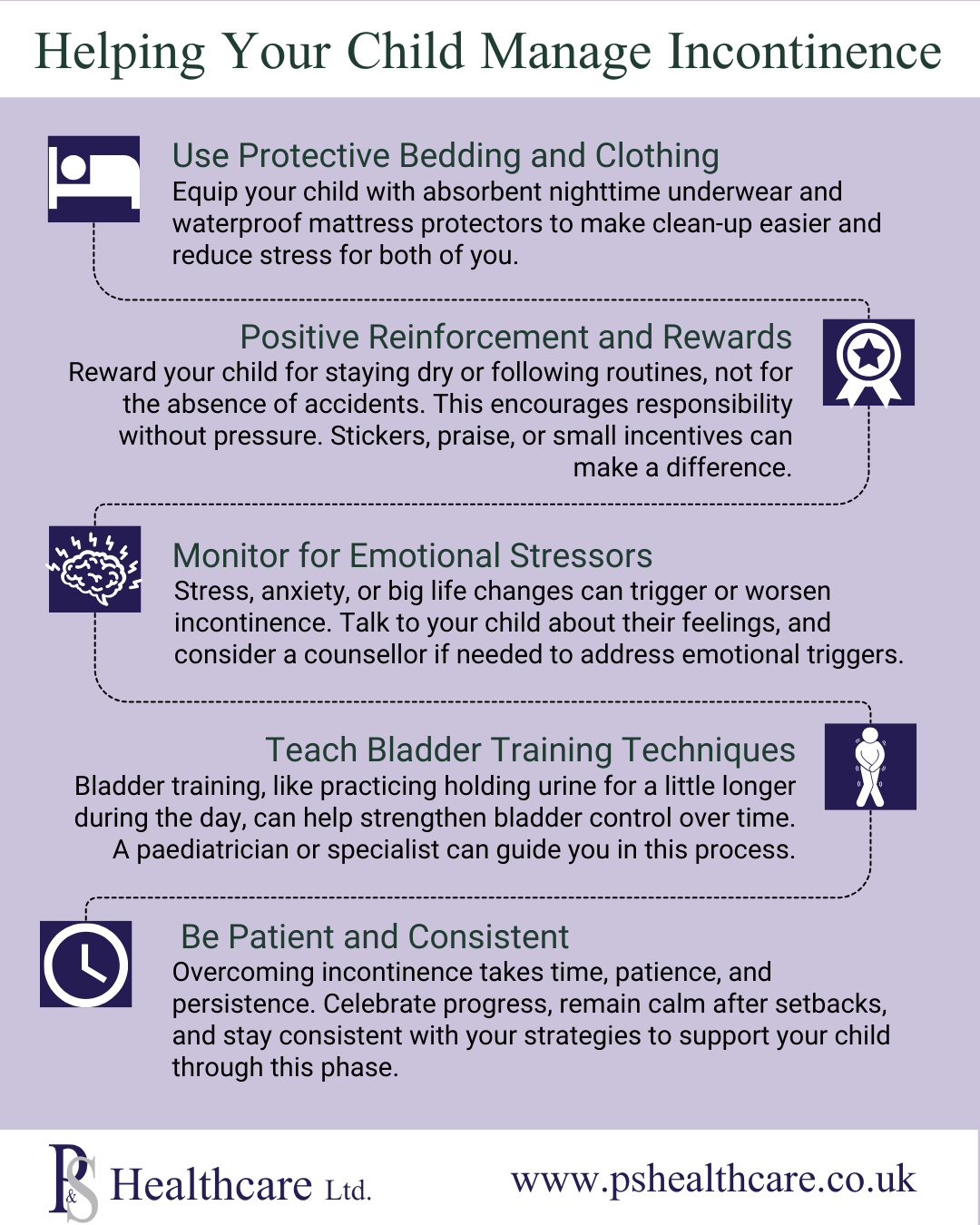Helping Your Child Manage Incontinence: A Parent's Resource

Incontinence can be a challenging experience for both children and their parents, but it's important to know you're not alone. With the right understanding and strategies, most children can overcome this phase with confidence and ease. Here's a guide to helping your child manage incontinence effectively and compassionately.
1. Understand the Condition
Incontinence, whether it occurs during the day or at night (commonly known as bedwetting), is more common than many parents realise. It’s often a temporary condition that children outgrow as they develop. Understanding the root cause, whether it's developmental, medical, or emotional, plays a critical role in addressing it effectively. Speak with a healthcare provider if you're unsure of the cause.
2. Create a Supportive Environment
Children can feel embarrassed or ashamed about incontinence, which may worsen the problem. As a parent, your role is to provide reassurance and support, making sure they know it’s a natural issue that many children experience. Avoid any negativity when accidents occur and focus on encouragement and understanding.
3. Consult with a Paediatrician/Doctor
If incontinence is persistent, consulting a paediatrician or doctor is essential. They can rule out potential medical issues such as urinary tract infections, constipation, or diabetes. Additionally, they can provide tailored advice to manage your child’s specific situation effectively.
4. Implement a Bathroom Routine
Encouraging regular bathroom breaks can help children establish better bladder control. Create a schedule for bathroom visits during the day and ensure your child uses the toilet before bedtime. A consistent routine can significantly reduce accidents and build healthy habits.
5. Limit Fluid Intake Before Bedtime
While staying hydrated is crucial, limiting fluid intake in the evening can help prevent nighttime accidents. Encourage your child to drink more during the day and avoid drinks with caffeine or high sugar content before bedtime.
6. Use Protective Bedding and Clothing
Accidents can be stressful for both you and your child. Waterproof mattress protectors and absorbent nighttime underwear can make clean-up easier while keeping your child comfortable. These tools reduce stress and help everyone sleep better.
7. Positive Reinforcement and Rewards
Celebrate progress with positive reinforcement. Reward your child for following routines or taking responsibility rather than focusing solely on the absence of accidents. Simple incentives like stickers, verbal praise, or small rewards can encourage your child without adding pressure.
8. Monitor for Emotional Stressors
Stress and anxiety can trigger or exacerbate incontinence. Big life changes, such as moving to a new home or starting school, can contribute to the problem. Talk openly with your child about their feelings and consider involving a counsellor if needed to address underlying emotional triggers.
9. Teach Bladder Training Techniques
Bladder training involves helping your child gradually increase their bladder control. This might include encouraging them to hold their urine for a little longer during the day or teaching them how to recognise the urge to go. A healthcare provider can guide you in implementing these techniques effectively.
10. Be Patient and Consistent
Overcoming incontinence is a process that requires time and persistence. Celebrate small victories and remain calm during setbacks. Consistency is key. Stick with the strategies you implement and continue to support your child with patience and understanding.
Managing incontinence can feel overwhelming, but with the right strategies and mindset, it’s a phase that your child can overcome. By understanding the condition, creating a supportive environment, and implementing practical solutions, you can help your child build confidence and navigate this challenge successfully.
Remember, every child is different, and progress may take time. Stay positive, patient, and proactive as you support your child through this journey.
Don't forget to download our useful Infographic, below:


More News:
- Christmas Confidence
- Real Women, Real Stories: Living Confidently with Washable Incontinence Pants
- A Real-Life Guide to Incontinence Bed Sheets & Washable Bed Pads
- The Environmental Benefits of Reusable Bedwetting Pants for Kids
- Men's Washable Incontinence Pants for Everyday Confidence: A User's Guide
- Top Features to Look for in Washable Incontinence Pants for Women
- 5 Mistakes to Avoid When Washing Your Reusable Incontinence Bed Pads
- The Best Bedwetting Pants for Children: What Parents Need to Know
- Male Washable Incontinence Pants vs. Disposable: Which Is Better?
- The Best Incontinence Pants for Women
- The Complete Guide to Washable Bed Pads & Incontinence Products
- How to Talk to Your Child About Incontinence: Supportive Parenting Strategies
- Incontinence Supplies for Men: What You Actually Need
- Washable Incontinence Pants for Women: A Comfortable, Eco-Friendly Solution
- Children's Incontinence Pants: How They Help Kids Stay Dry and Confident
- Why More Men Are Switching to Washable Incontinence Pads and Pants
- Managing Incontinence as a Woman: Tips for Travel, Work, and Home Life
- The Best Washable Incontinence Pants in the UK
- Real Stories from Families Using Children's Nighttime Pants
- Caring for a Loved One? A Carer's Guide to Incontinence Supplies for Men
- Why Ladies Washable Incontinence Pants Are Better for the Planet
- Understanding Why Older Children Still Wet the Bed and What You Can Do About It
- Travelling with Incontinence: Best Washable Incontinence Pants for Men on the Go
- Your Guide to Washable Incontinence Pants for Ladies: FAQs Answered
- The Benefits of Switching to Washable Incontinence Products
- 8 Everyday Activities That Can Strengthen or Weaken Your Bladder
- 10 Things You Should Pack in an Incontinence Emergency Kit
- 10 Foods to Eat and Avoid for Better Bowel Control
- 8 Ways Stress and Anxiety Can Affect Bladder Health
- 10 Signs It's Time to See a Doctor About Your Urinary Incontinence
- 10 Tips for Talking to Your Child About Bedwetting
- 10 Things You Should Know About Postpartum Incontinence
- 10 Common Triggers of Urinary Incontinence in Women Over 50
- 10 Tips for Night-Time Incontinence Management in Adults
- 10 Ways to Manage Incontinence While Playing Sports
- Your Incontinence Options: Finding the Right Solution for You
- 10 Tips for Managing Faecal Incontinence in Adults
- 10 Lifestyle Changes to Manage Urinary Incontinence Symptoms
- 10 Ways to Manage Urinary Incontinence During Pregnancy
- 10 Causes of Urinary Incontinence in Men and How to Treat Them
- 10 Practical Solutions for Coping with Incontinence at Work
- 10 Myths About Menopause and Incontinence You Should Stop Believing
- 10 Foods to Avoid to Prevent Bladder Irritation and Incontinence
- 10 Effective Pelvic Floor Exercises for Urinary Incontinence
- 10 Common Causes of Bedwetting in Children and How to Address Them
- Causes of Faecal Incontinence
- Breaking the Silence: Managing Incontinence with Confidence
- Supporting Loved Ones with Incontinence: A Caregiver's Guide
- Top 10 Tips for Managing Incontinence Comfortably This Christmas
- Pregnancy and Postpartum Incontinence: Prevention and Recovery
- 10 Random Facts About Pee You Probably Didn't Know
- Diet and Bladder Health: Foods That Help and Hurt
- Helping Your Child Manage Incontinence: A Parent's Resource
- The Most Common Bladder Control Problems and How to Manage Them
- 10 Things That Can Make Incontinence Worse
- Incontinence Myths vs Facts - Dispelling Common Misconceptions
- Top 10 tips to help with bladder control during pregnancy
- 10 Effective Ways to Stop Bladder Leaks & Manage Incontinence
- P&S Washable Face Mask with ViralOff
- New Product For Men - The Slip Brief
- New Monthly Protection Briefs For Women
- New Product - The OooPS Pant for Stress Incontinence
- New Adult Inco-elite Range Launched
- EMDA WOMEN OF WORTH AWARD 2009
- New Website Launched
- New Website Under Development

